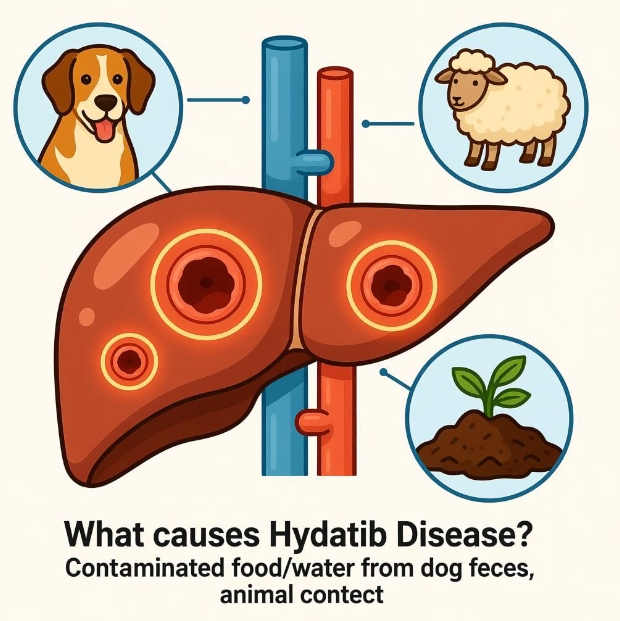Hepatic hydatid disease (hepatic echinococcosis) is a zoonotic infection caused by the larval stage of Echinococcus granulosus or E. multilocularis. Its presentation is dictated by cyst number, size, location, integrity, and associated complications. Many patients remain asymptomatic for years; symptoms emerge only when growing cysts exert a mass effect, rupture, or become secondarily infected.
- Pain and right-upper-quadrant discomfort
A constant dull ache or sensation of fullness develops beneath the costal margin as the cyst expands or stretches Glisson’s capsule; sudden sharp pain heralds cyst rupture or intracystic haemorrhage. - Palpable hepatic mass
Inspection reveals asymmetric abdominal bulging; palpation detects a smooth, resilient, ballotable mass that moves with respiration and is dull to percussion. - Dyspeptic complaints
Early satiety, eructation, nausea and occasional vomiting occur when a large cyst compresses the stomach or duodenum. - Jaundice and cholestasis
Obstruction of segmental bile ducts by daughter cysts or external compression of the common hepatic duct produces fluctuating conjugated hyper-bilirubinaemia, dark urine and pale stools. - Acute hypersensitivity phenomena
Leakage or spontaneous rupture releases antigen-rich cyst fluid, provoking urticaria, pruritus, eosinophilia, or life-threatening anaphylaxis with hypotension and bronchospasm. - Secondary infection and suppuration
Fever, rigors and right-upper-quadrant tenderness appear when bacteria colonise the cyst, converting it into an abscess; laboratory studies show leucocytosis and raised C-reactive protein. - Vascular and biliary fistulae
Rupture into the biliary tree causes cholangitis, recurrent pyrexia and Charcot triad; communication with the portal vein or hepatic artery may lead to acute haemobilia with melena and anaemia. - Systemic features
Chronic weight loss, fatigue and low-grade fever reflect long-standing inflammation and diminished oral intake. - Parasitic dissemination
Implantation of protoscolices along the peritoneal or pleural surfaces produces secondary cysts, presenting months or years later as abdominal masses or pleural nodules.
| Symptom / Sign | Typical Presentation |
|---|---|
| RUQ pain | Dull ache; sudden if rupture/haemorrhage |
| Palpable mass | Smooth, ballotable, moves with respiration |
| Dyspepsia | Early satiety, nausea, eructation |
| Jaundice | Fluctuating; daughter-cyst obstruction |
| Hypersensitivity | Urticaria, pruritus, eosinophilia, anaphylaxis |
| Secondary infection | Fever, rigors, tenderness, leucocytosis |
| Biliary fistula | Cholangitis, Charcot triad, haemobilia |
| Systemic | Weight loss, fatigue, low-grade fever |
| Dissemination | Secondary peritoneal or pleural cysts |
